Implementation of TQM and Customer Satisfaction in Romania Textiles
VerifiedAdded on 2023/01/05
|73
|18288
|49
Report
AI Summary
This report investigates the impact of Total Quality Management (TQM) on customer satisfaction within the Romanian textile industry. The study explores the industry's background, its significance to the Romanian economy, and the challenges it faces, particularly concerning technological innovation. The research examines the influence of various aspects of TQM, such as product quality (spinning, fiber forming, knitting, weaving, dyeing, and finishing), employee presentation, customer confidence, safety, and brand availability, on customer satisfaction. The findings reveal that focusing on quality improvement and employee presentation significantly enhances customer satisfaction. The report emphasizes the importance of investment in employee empowerment and a commitment to high-quality products and services to fully leverage the benefits of TQM. This research aims to provide insights into how TQM can be effectively implemented to improve the competitiveness and customer satisfaction within the Romanian textile sector.
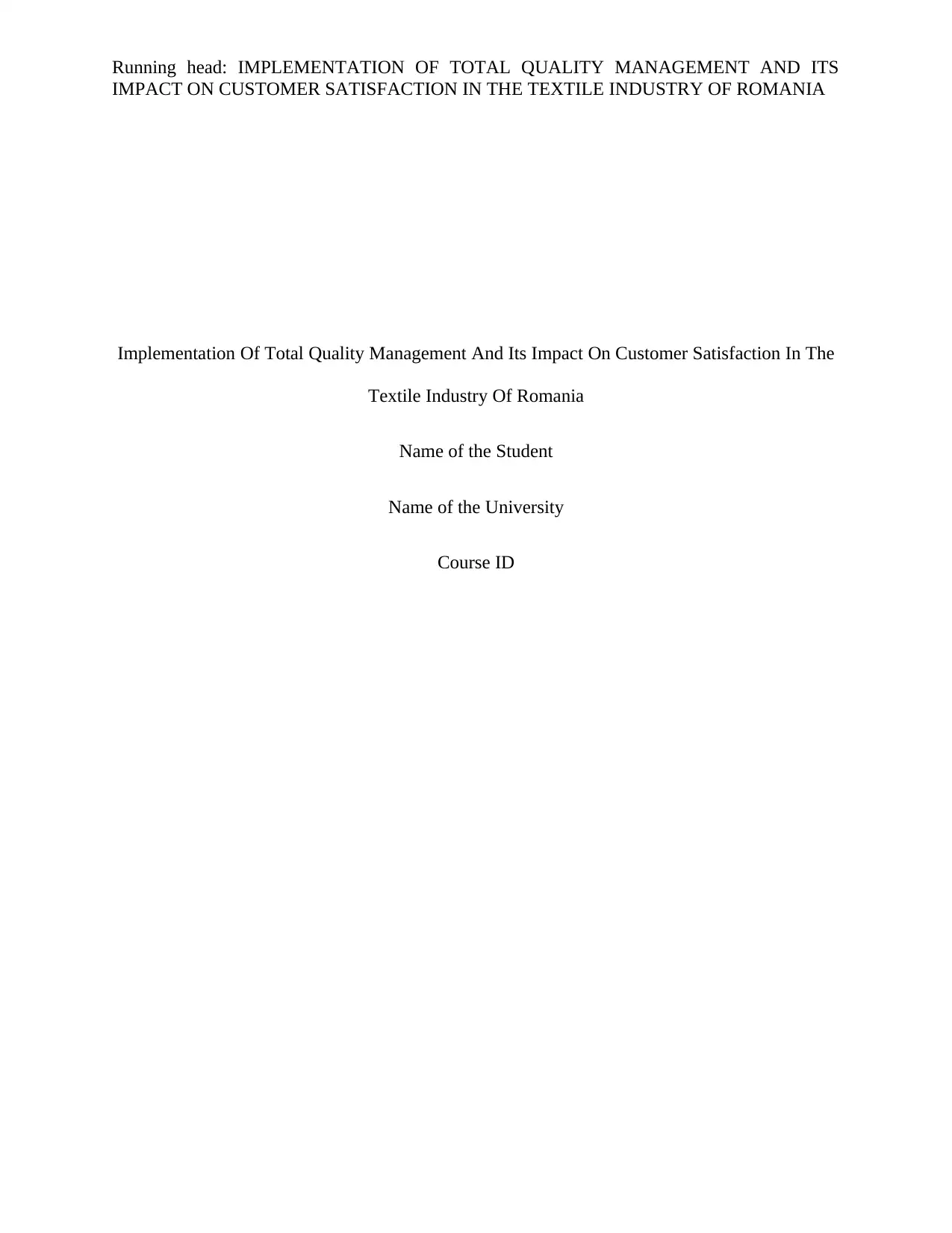
Running head: IMPLEMENTATION OF TOTAL QUALITY MANAGEMENT AND ITS
IMPACT ON CUSTOMER SATISFACTION IN THE TEXTILE INDUSTRY OF ROMANIA
Implementation Of Total Quality Management And Its Impact On Customer Satisfaction In The
Textile Industry Of Romania
Name of the Student
Name of the University
Course ID
IMPACT ON CUSTOMER SATISFACTION IN THE TEXTILE INDUSTRY OF ROMANIA
Implementation Of Total Quality Management And Its Impact On Customer Satisfaction In The
Textile Industry Of Romania
Name of the Student
Name of the University
Course ID
Paraphrase This Document
Need a fresh take? Get an instant paraphrase of this document with our AI Paraphraser
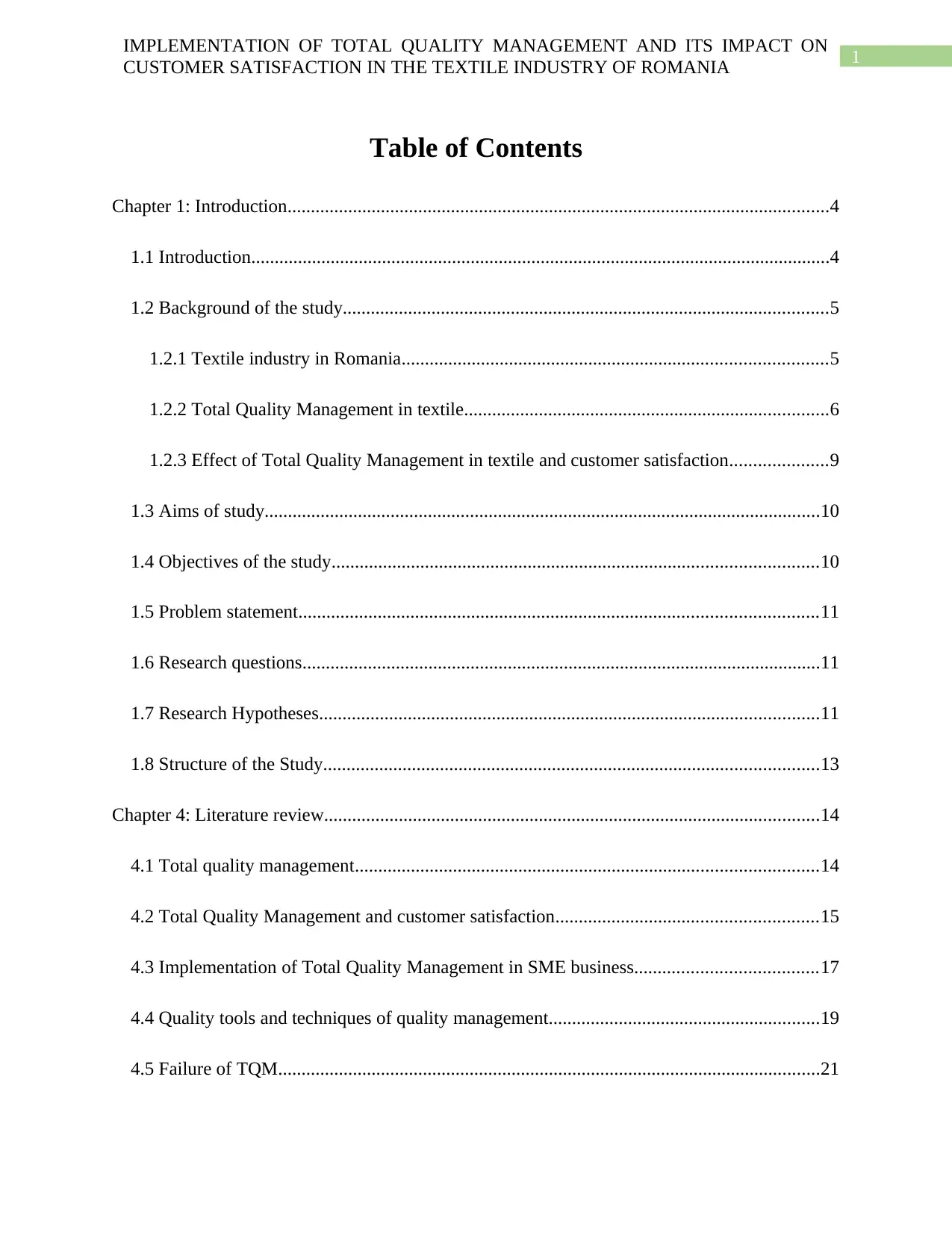
1
IMPLEMENTATION OF TOTAL QUALITY MANAGEMENT AND ITS IMPACT ON
CUSTOMER SATISFACTION IN THE TEXTILE INDUSTRY OF ROMANIA
Table of Contents
Chapter 1: Introduction....................................................................................................................4
1.1 Introduction............................................................................................................................4
1.2 Background of the study........................................................................................................5
1.2.1 Textile industry in Romania...........................................................................................5
1.2.2 Total Quality Management in textile..............................................................................6
1.2.3 Effect of Total Quality Management in textile and customer satisfaction.....................9
1.3 Aims of study.......................................................................................................................10
1.4 Objectives of the study........................................................................................................10
1.5 Problem statement...............................................................................................................11
1.6 Research questions...............................................................................................................11
1.7 Research Hypotheses...........................................................................................................11
1.8 Structure of the Study..........................................................................................................13
Chapter 4: Literature review..........................................................................................................14
4.1 Total quality management...................................................................................................14
4.2 Total Quality Management and customer satisfaction........................................................15
4.3 Implementation of Total Quality Management in SME business.......................................17
4.4 Quality tools and techniques of quality management..........................................................19
4.5 Failure of TQM....................................................................................................................21
IMPLEMENTATION OF TOTAL QUALITY MANAGEMENT AND ITS IMPACT ON
CUSTOMER SATISFACTION IN THE TEXTILE INDUSTRY OF ROMANIA
Table of Contents
Chapter 1: Introduction....................................................................................................................4
1.1 Introduction............................................................................................................................4
1.2 Background of the study........................................................................................................5
1.2.1 Textile industry in Romania...........................................................................................5
1.2.2 Total Quality Management in textile..............................................................................6
1.2.3 Effect of Total Quality Management in textile and customer satisfaction.....................9
1.3 Aims of study.......................................................................................................................10
1.4 Objectives of the study........................................................................................................10
1.5 Problem statement...............................................................................................................11
1.6 Research questions...............................................................................................................11
1.7 Research Hypotheses...........................................................................................................11
1.8 Structure of the Study..........................................................................................................13
Chapter 4: Literature review..........................................................................................................14
4.1 Total quality management...................................................................................................14
4.2 Total Quality Management and customer satisfaction........................................................15
4.3 Implementation of Total Quality Management in SME business.......................................17
4.4 Quality tools and techniques of quality management..........................................................19
4.5 Failure of TQM....................................................................................................................21
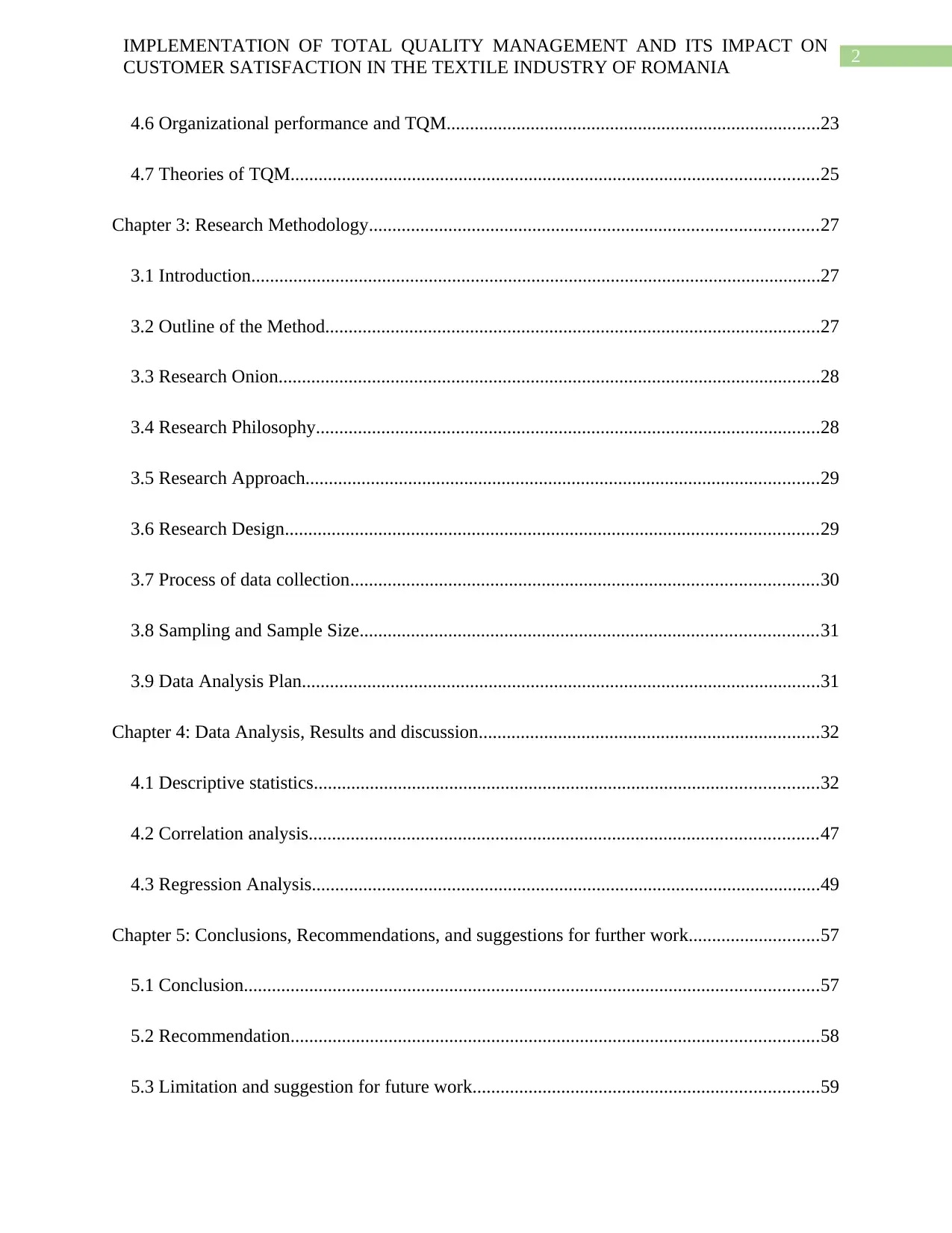
2
IMPLEMENTATION OF TOTAL QUALITY MANAGEMENT AND ITS IMPACT ON
CUSTOMER SATISFACTION IN THE TEXTILE INDUSTRY OF ROMANIA
4.6 Organizational performance and TQM................................................................................23
4.7 Theories of TQM.................................................................................................................25
Chapter 3: Research Methodology................................................................................................27
3.1 Introduction..........................................................................................................................27
3.2 Outline of the Method..........................................................................................................27
3.3 Research Onion....................................................................................................................28
3.4 Research Philosophy............................................................................................................28
3.5 Research Approach..............................................................................................................29
3.6 Research Design..................................................................................................................29
3.7 Process of data collection....................................................................................................30
3.8 Sampling and Sample Size..................................................................................................31
3.9 Data Analysis Plan...............................................................................................................31
Chapter 4: Data Analysis, Results and discussion.........................................................................32
4.1 Descriptive statistics............................................................................................................32
4.2 Correlation analysis.............................................................................................................47
4.3 Regression Analysis.............................................................................................................49
Chapter 5: Conclusions, Recommendations, and suggestions for further work............................57
5.1 Conclusion...........................................................................................................................57
5.2 Recommendation.................................................................................................................58
5.3 Limitation and suggestion for future work..........................................................................59
IMPLEMENTATION OF TOTAL QUALITY MANAGEMENT AND ITS IMPACT ON
CUSTOMER SATISFACTION IN THE TEXTILE INDUSTRY OF ROMANIA
4.6 Organizational performance and TQM................................................................................23
4.7 Theories of TQM.................................................................................................................25
Chapter 3: Research Methodology................................................................................................27
3.1 Introduction..........................................................................................................................27
3.2 Outline of the Method..........................................................................................................27
3.3 Research Onion....................................................................................................................28
3.4 Research Philosophy............................................................................................................28
3.5 Research Approach..............................................................................................................29
3.6 Research Design..................................................................................................................29
3.7 Process of data collection....................................................................................................30
3.8 Sampling and Sample Size..................................................................................................31
3.9 Data Analysis Plan...............................................................................................................31
Chapter 4: Data Analysis, Results and discussion.........................................................................32
4.1 Descriptive statistics............................................................................................................32
4.2 Correlation analysis.............................................................................................................47
4.3 Regression Analysis.............................................................................................................49
Chapter 5: Conclusions, Recommendations, and suggestions for further work............................57
5.1 Conclusion...........................................................................................................................57
5.2 Recommendation.................................................................................................................58
5.3 Limitation and suggestion for future work..........................................................................59
⊘ This is a preview!⊘
Do you want full access?
Subscribe today to unlock all pages.

Trusted by 1+ million students worldwide
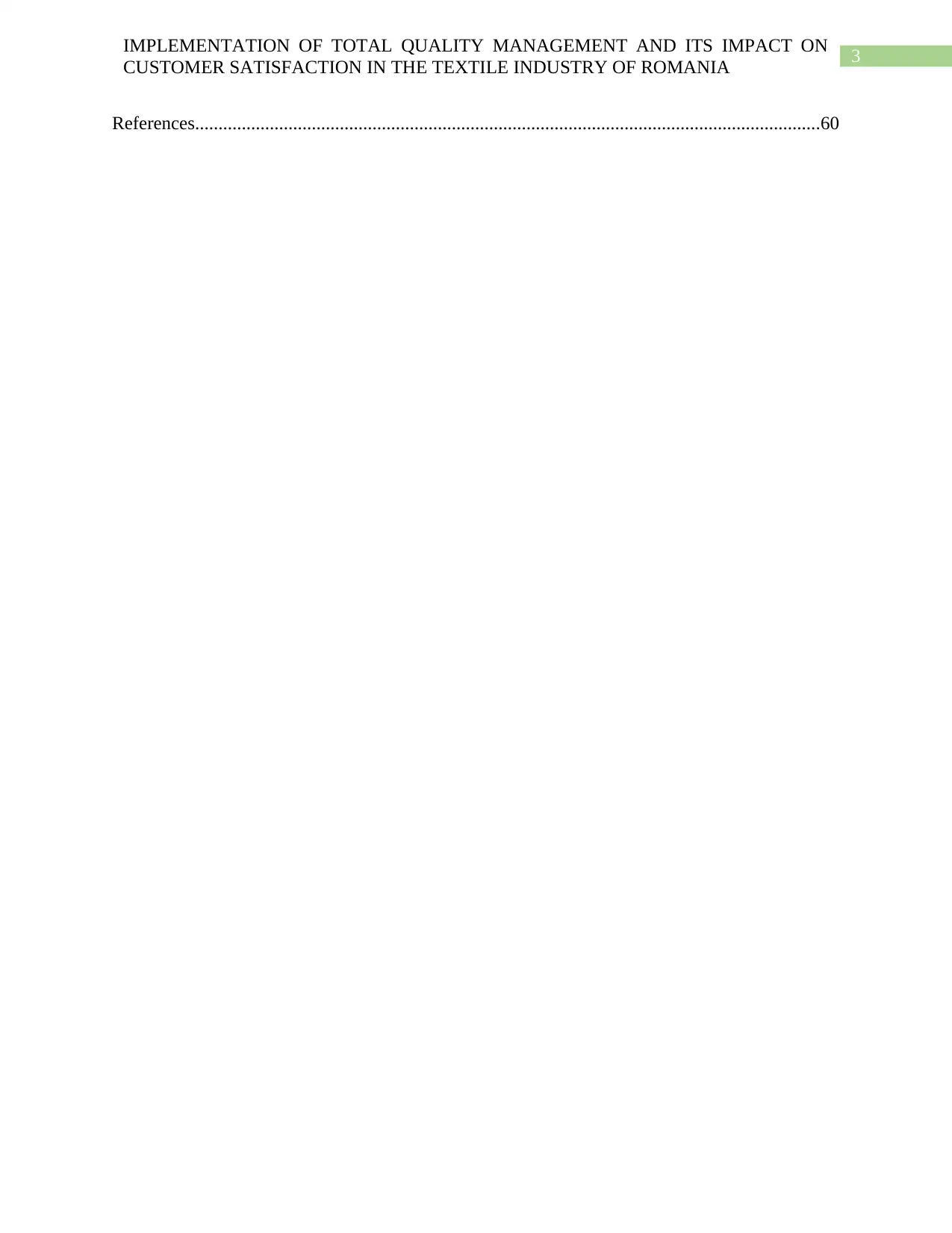
3
IMPLEMENTATION OF TOTAL QUALITY MANAGEMENT AND ITS IMPACT ON
CUSTOMER SATISFACTION IN THE TEXTILE INDUSTRY OF ROMANIA
References......................................................................................................................................60
IMPLEMENTATION OF TOTAL QUALITY MANAGEMENT AND ITS IMPACT ON
CUSTOMER SATISFACTION IN THE TEXTILE INDUSTRY OF ROMANIA
References......................................................................................................................................60
Paraphrase This Document
Need a fresh take? Get an instant paraphrase of this document with our AI Paraphraser
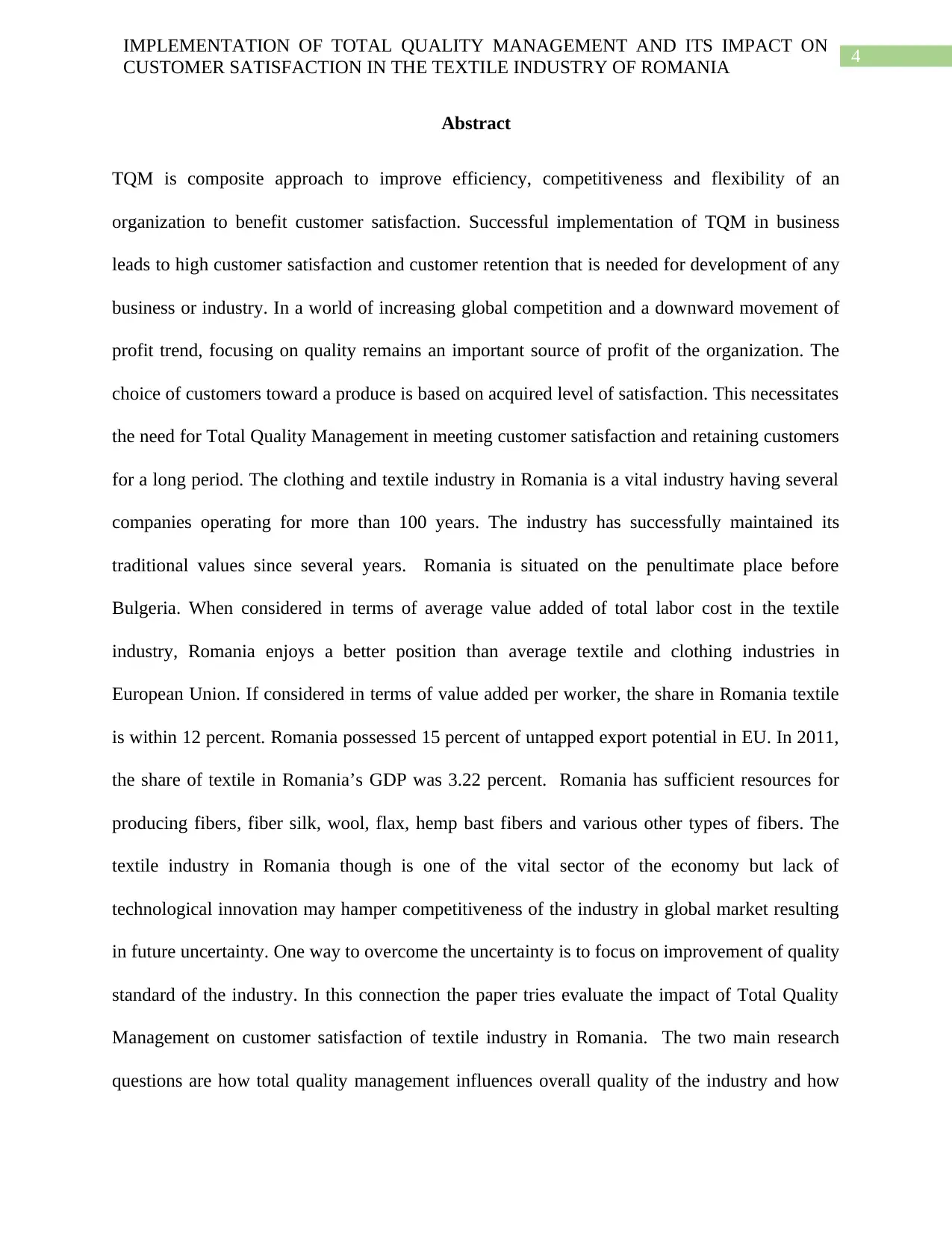
4
IMPLEMENTATION OF TOTAL QUALITY MANAGEMENT AND ITS IMPACT ON
CUSTOMER SATISFACTION IN THE TEXTILE INDUSTRY OF ROMANIA
Abstract
TQM is composite approach to improve efficiency, competitiveness and flexibility of an
organization to benefit customer satisfaction. Successful implementation of TQM in business
leads to high customer satisfaction and customer retention that is needed for development of any
business or industry. In a world of increasing global competition and a downward movement of
profit trend, focusing on quality remains an important source of profit of the organization. The
choice of customers toward a produce is based on acquired level of satisfaction. This necessitates
the need for Total Quality Management in meeting customer satisfaction and retaining customers
for a long period. The clothing and textile industry in Romania is a vital industry having several
companies operating for more than 100 years. The industry has successfully maintained its
traditional values since several years. Romania is situated on the penultimate place before
Bulgeria. When considered in terms of average value added of total labor cost in the textile
industry, Romania enjoys a better position than average textile and clothing industries in
European Union. If considered in terms of value added per worker, the share in Romania textile
is within 12 percent. Romania possessed 15 percent of untapped export potential in EU. In 2011,
the share of textile in Romania’s GDP was 3.22 percent. Romania has sufficient resources for
producing fibers, fiber silk, wool, flax, hemp bast fibers and various other types of fibers. The
textile industry in Romania though is one of the vital sector of the economy but lack of
technological innovation may hamper competitiveness of the industry in global market resulting
in future uncertainty. One way to overcome the uncertainty is to focus on improvement of quality
standard of the industry. In this connection the paper tries evaluate the impact of Total Quality
Management on customer satisfaction of textile industry in Romania. The two main research
questions are how total quality management influences overall quality of the industry and how
IMPLEMENTATION OF TOTAL QUALITY MANAGEMENT AND ITS IMPACT ON
CUSTOMER SATISFACTION IN THE TEXTILE INDUSTRY OF ROMANIA
Abstract
TQM is composite approach to improve efficiency, competitiveness and flexibility of an
organization to benefit customer satisfaction. Successful implementation of TQM in business
leads to high customer satisfaction and customer retention that is needed for development of any
business or industry. In a world of increasing global competition and a downward movement of
profit trend, focusing on quality remains an important source of profit of the organization. The
choice of customers toward a produce is based on acquired level of satisfaction. This necessitates
the need for Total Quality Management in meeting customer satisfaction and retaining customers
for a long period. The clothing and textile industry in Romania is a vital industry having several
companies operating for more than 100 years. The industry has successfully maintained its
traditional values since several years. Romania is situated on the penultimate place before
Bulgeria. When considered in terms of average value added of total labor cost in the textile
industry, Romania enjoys a better position than average textile and clothing industries in
European Union. If considered in terms of value added per worker, the share in Romania textile
is within 12 percent. Romania possessed 15 percent of untapped export potential in EU. In 2011,
the share of textile in Romania’s GDP was 3.22 percent. Romania has sufficient resources for
producing fibers, fiber silk, wool, flax, hemp bast fibers and various other types of fibers. The
textile industry in Romania though is one of the vital sector of the economy but lack of
technological innovation may hamper competitiveness of the industry in global market resulting
in future uncertainty. One way to overcome the uncertainty is to focus on improvement of quality
standard of the industry. In this connection the paper tries evaluate the impact of Total Quality
Management on customer satisfaction of textile industry in Romania. The two main research
questions are how total quality management influences overall quality of the industry and how
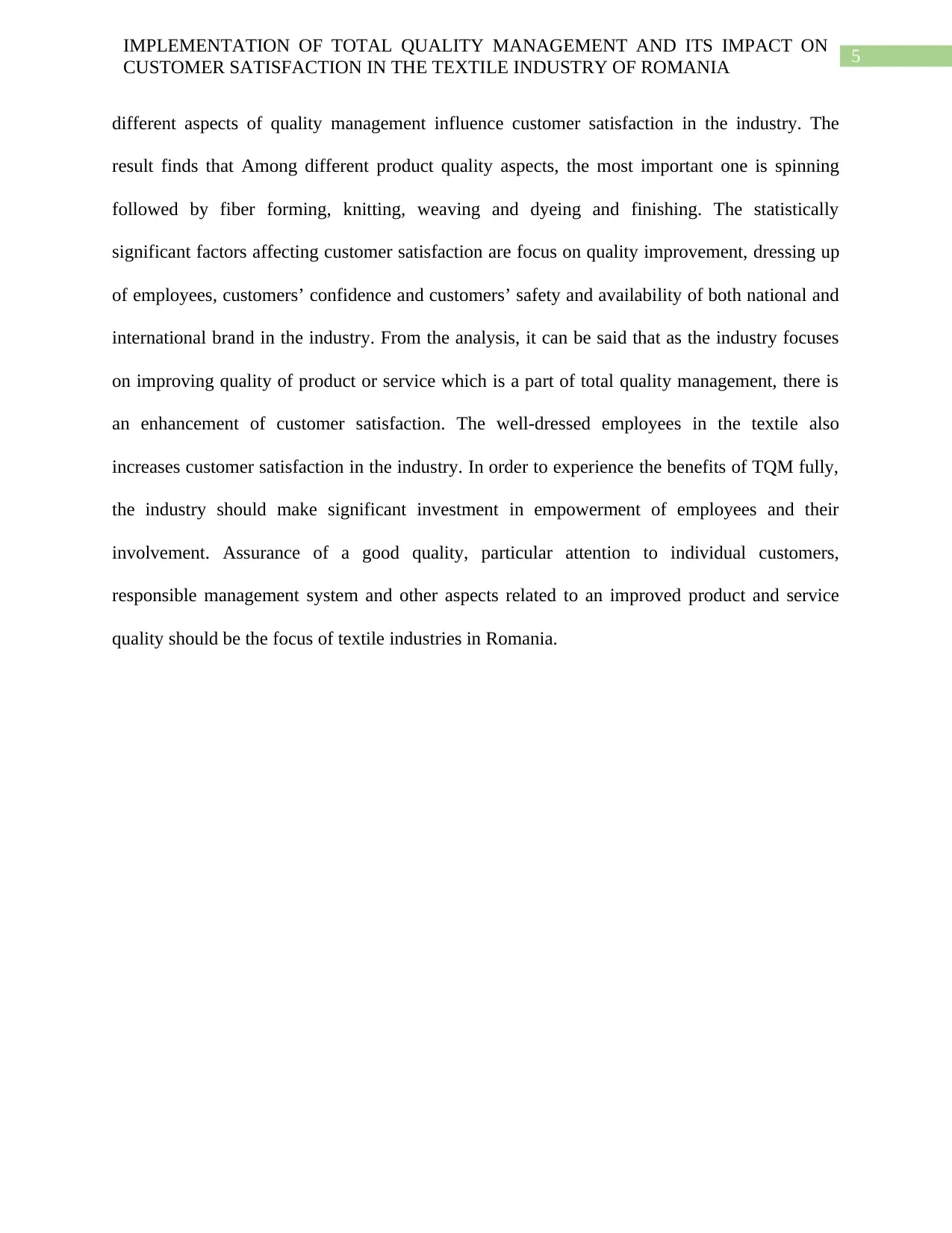
5
IMPLEMENTATION OF TOTAL QUALITY MANAGEMENT AND ITS IMPACT ON
CUSTOMER SATISFACTION IN THE TEXTILE INDUSTRY OF ROMANIA
different aspects of quality management influence customer satisfaction in the industry. The
result finds that Among different product quality aspects, the most important one is spinning
followed by fiber forming, knitting, weaving and dyeing and finishing. The statistically
significant factors affecting customer satisfaction are focus on quality improvement, dressing up
of employees, customers’ confidence and customers’ safety and availability of both national and
international brand in the industry. From the analysis, it can be said that as the industry focuses
on improving quality of product or service which is a part of total quality management, there is
an enhancement of customer satisfaction. The well-dressed employees in the textile also
increases customer satisfaction in the industry. In order to experience the benefits of TQM fully,
the industry should make significant investment in empowerment of employees and their
involvement. Assurance of a good quality, particular attention to individual customers,
responsible management system and other aspects related to an improved product and service
quality should be the focus of textile industries in Romania.
IMPLEMENTATION OF TOTAL QUALITY MANAGEMENT AND ITS IMPACT ON
CUSTOMER SATISFACTION IN THE TEXTILE INDUSTRY OF ROMANIA
different aspects of quality management influence customer satisfaction in the industry. The
result finds that Among different product quality aspects, the most important one is spinning
followed by fiber forming, knitting, weaving and dyeing and finishing. The statistically
significant factors affecting customer satisfaction are focus on quality improvement, dressing up
of employees, customers’ confidence and customers’ safety and availability of both national and
international brand in the industry. From the analysis, it can be said that as the industry focuses
on improving quality of product or service which is a part of total quality management, there is
an enhancement of customer satisfaction. The well-dressed employees in the textile also
increases customer satisfaction in the industry. In order to experience the benefits of TQM fully,
the industry should make significant investment in empowerment of employees and their
involvement. Assurance of a good quality, particular attention to individual customers,
responsible management system and other aspects related to an improved product and service
quality should be the focus of textile industries in Romania.
⊘ This is a preview!⊘
Do you want full access?
Subscribe today to unlock all pages.

Trusted by 1+ million students worldwide
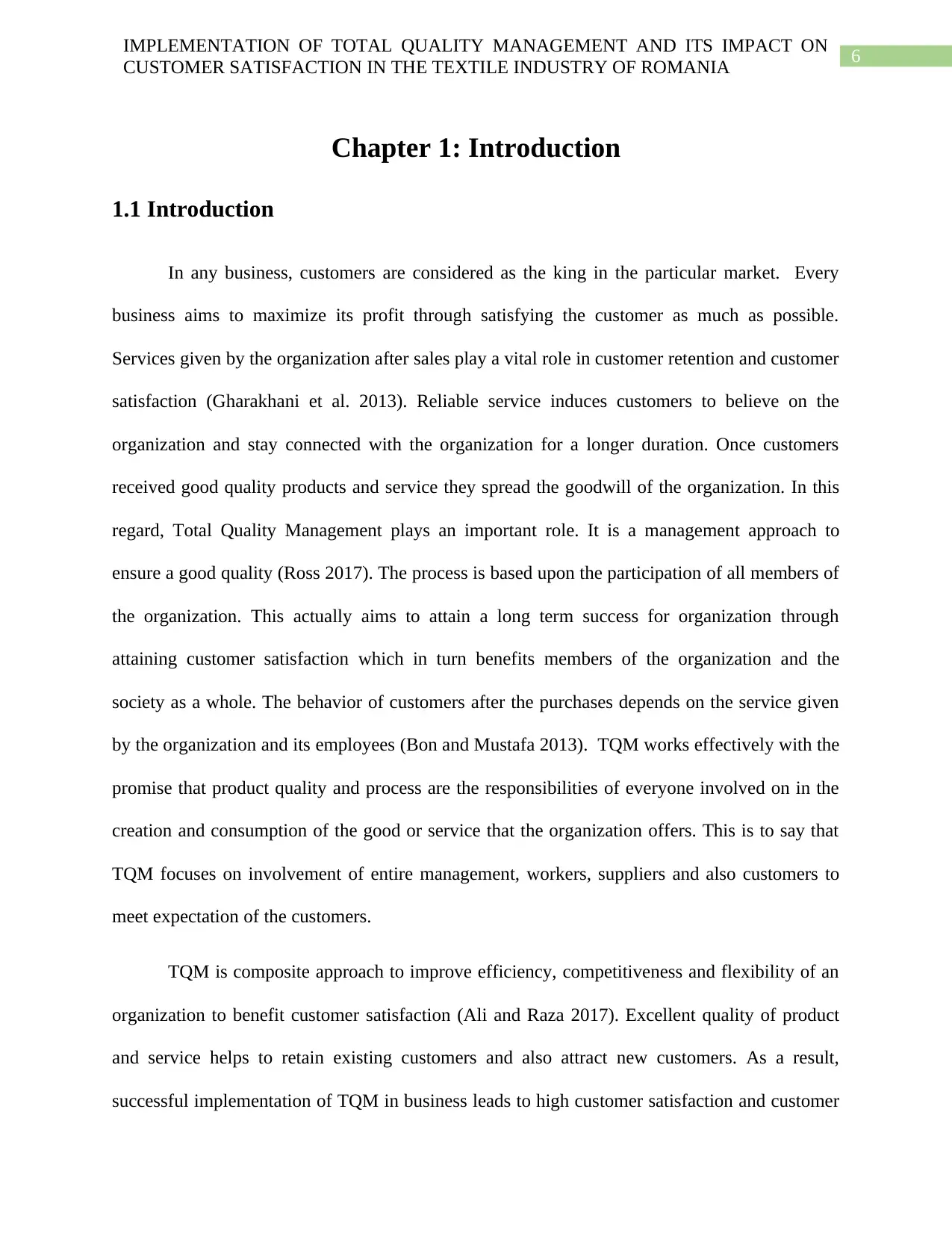
6
IMPLEMENTATION OF TOTAL QUALITY MANAGEMENT AND ITS IMPACT ON
CUSTOMER SATISFACTION IN THE TEXTILE INDUSTRY OF ROMANIA
Chapter 1: Introduction
1.1 Introduction
In any business, customers are considered as the king in the particular market. Every
business aims to maximize its profit through satisfying the customer as much as possible.
Services given by the organization after sales play a vital role in customer retention and customer
satisfaction (Gharakhani et al. 2013). Reliable service induces customers to believe on the
organization and stay connected with the organization for a longer duration. Once customers
received good quality products and service they spread the goodwill of the organization. In this
regard, Total Quality Management plays an important role. It is a management approach to
ensure a good quality (Ross 2017). The process is based upon the participation of all members of
the organization. This actually aims to attain a long term success for organization through
attaining customer satisfaction which in turn benefits members of the organization and the
society as a whole. The behavior of customers after the purchases depends on the service given
by the organization and its employees (Bon and Mustafa 2013). TQM works effectively with the
promise that product quality and process are the responsibilities of everyone involved on in the
creation and consumption of the good or service that the organization offers. This is to say that
TQM focuses on involvement of entire management, workers, suppliers and also customers to
meet expectation of the customers.
TQM is composite approach to improve efficiency, competitiveness and flexibility of an
organization to benefit customer satisfaction (Ali and Raza 2017). Excellent quality of product
and service helps to retain existing customers and also attract new customers. As a result,
successful implementation of TQM in business leads to high customer satisfaction and customer
IMPLEMENTATION OF TOTAL QUALITY MANAGEMENT AND ITS IMPACT ON
CUSTOMER SATISFACTION IN THE TEXTILE INDUSTRY OF ROMANIA
Chapter 1: Introduction
1.1 Introduction
In any business, customers are considered as the king in the particular market. Every
business aims to maximize its profit through satisfying the customer as much as possible.
Services given by the organization after sales play a vital role in customer retention and customer
satisfaction (Gharakhani et al. 2013). Reliable service induces customers to believe on the
organization and stay connected with the organization for a longer duration. Once customers
received good quality products and service they spread the goodwill of the organization. In this
regard, Total Quality Management plays an important role. It is a management approach to
ensure a good quality (Ross 2017). The process is based upon the participation of all members of
the organization. This actually aims to attain a long term success for organization through
attaining customer satisfaction which in turn benefits members of the organization and the
society as a whole. The behavior of customers after the purchases depends on the service given
by the organization and its employees (Bon and Mustafa 2013). TQM works effectively with the
promise that product quality and process are the responsibilities of everyone involved on in the
creation and consumption of the good or service that the organization offers. This is to say that
TQM focuses on involvement of entire management, workers, suppliers and also customers to
meet expectation of the customers.
TQM is composite approach to improve efficiency, competitiveness and flexibility of an
organization to benefit customer satisfaction (Ali and Raza 2017). Excellent quality of product
and service helps to retain existing customers and also attract new customers. As a result,
successful implementation of TQM in business leads to high customer satisfaction and customer
Paraphrase This Document
Need a fresh take? Get an instant paraphrase of this document with our AI Paraphraser
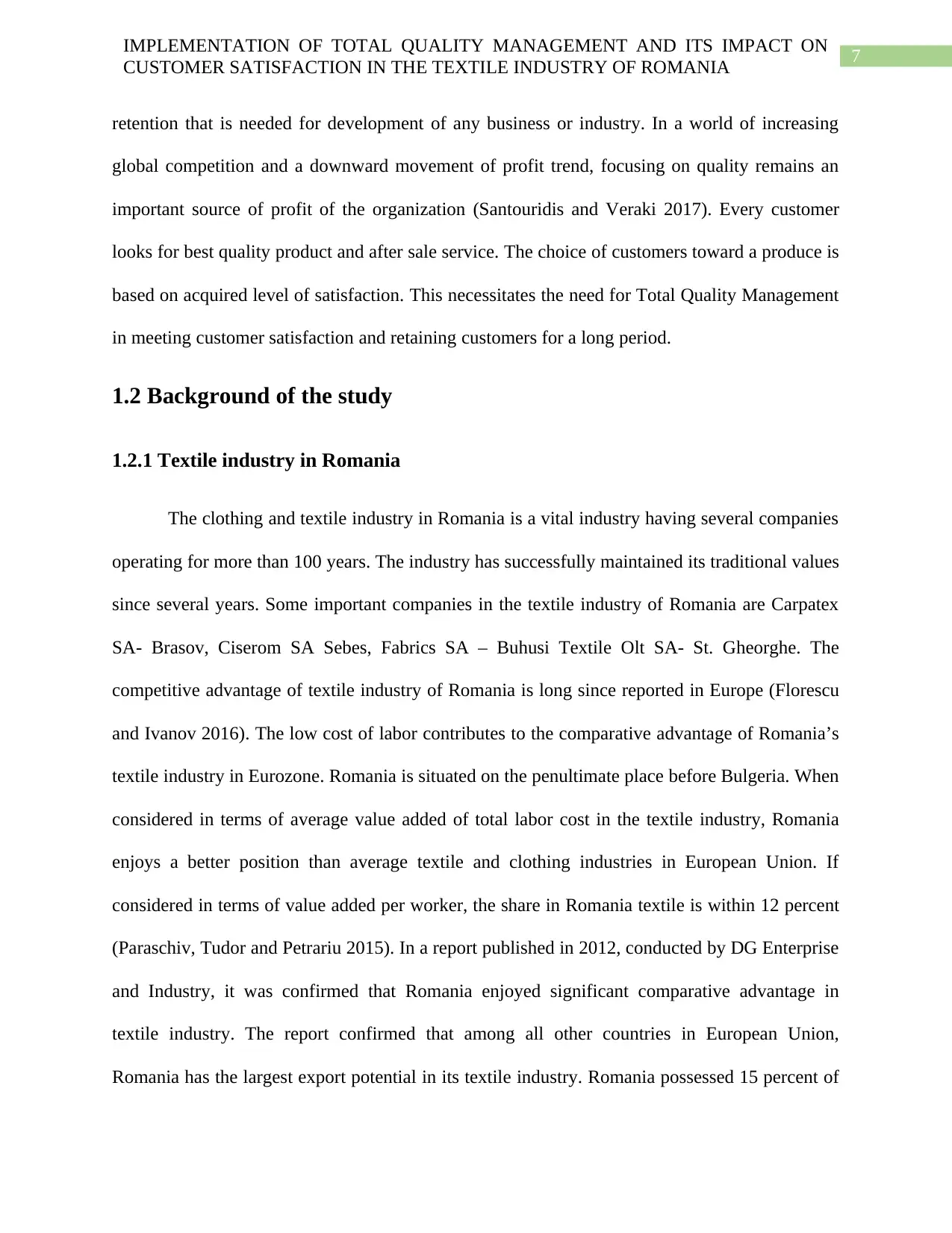
7
IMPLEMENTATION OF TOTAL QUALITY MANAGEMENT AND ITS IMPACT ON
CUSTOMER SATISFACTION IN THE TEXTILE INDUSTRY OF ROMANIA
retention that is needed for development of any business or industry. In a world of increasing
global competition and a downward movement of profit trend, focusing on quality remains an
important source of profit of the organization (Santouridis and Veraki 2017). Every customer
looks for best quality product and after sale service. The choice of customers toward a produce is
based on acquired level of satisfaction. This necessitates the need for Total Quality Management
in meeting customer satisfaction and retaining customers for a long period.
1.2 Background of the study
1.2.1 Textile industry in Romania
The clothing and textile industry in Romania is a vital industry having several companies
operating for more than 100 years. The industry has successfully maintained its traditional values
since several years. Some important companies in the textile industry of Romania are Carpatex
SA- Brasov, Ciserom SA Sebes, Fabrics SA – Buhusi Textile Olt SA- St. Gheorghe. The
competitive advantage of textile industry of Romania is long since reported in Europe (Florescu
and Ivanov 2016). The low cost of labor contributes to the comparative advantage of Romania’s
textile industry in Eurozone. Romania is situated on the penultimate place before Bulgeria. When
considered in terms of average value added of total labor cost in the textile industry, Romania
enjoys a better position than average textile and clothing industries in European Union. If
considered in terms of value added per worker, the share in Romania textile is within 12 percent
(Paraschiv, Tudor and Petrariu 2015). In a report published in 2012, conducted by DG Enterprise
and Industry, it was confirmed that Romania enjoyed significant comparative advantage in
textile industry. The report confirmed that among all other countries in European Union,
Romania has the largest export potential in its textile industry. Romania possessed 15 percent of
IMPLEMENTATION OF TOTAL QUALITY MANAGEMENT AND ITS IMPACT ON
CUSTOMER SATISFACTION IN THE TEXTILE INDUSTRY OF ROMANIA
retention that is needed for development of any business or industry. In a world of increasing
global competition and a downward movement of profit trend, focusing on quality remains an
important source of profit of the organization (Santouridis and Veraki 2017). Every customer
looks for best quality product and after sale service. The choice of customers toward a produce is
based on acquired level of satisfaction. This necessitates the need for Total Quality Management
in meeting customer satisfaction and retaining customers for a long period.
1.2 Background of the study
1.2.1 Textile industry in Romania
The clothing and textile industry in Romania is a vital industry having several companies
operating for more than 100 years. The industry has successfully maintained its traditional values
since several years. Some important companies in the textile industry of Romania are Carpatex
SA- Brasov, Ciserom SA Sebes, Fabrics SA – Buhusi Textile Olt SA- St. Gheorghe. The
competitive advantage of textile industry of Romania is long since reported in Europe (Florescu
and Ivanov 2016). The low cost of labor contributes to the comparative advantage of Romania’s
textile industry in Eurozone. Romania is situated on the penultimate place before Bulgeria. When
considered in terms of average value added of total labor cost in the textile industry, Romania
enjoys a better position than average textile and clothing industries in European Union. If
considered in terms of value added per worker, the share in Romania textile is within 12 percent
(Paraschiv, Tudor and Petrariu 2015). In a report published in 2012, conducted by DG Enterprise
and Industry, it was confirmed that Romania enjoyed significant comparative advantage in
textile industry. The report confirmed that among all other countries in European Union,
Romania has the largest export potential in its textile industry. Romania possessed 15 percent of

8
IMPLEMENTATION OF TOTAL QUALITY MANAGEMENT AND ITS IMPACT ON
CUSTOMER SATISFACTION IN THE TEXTILE INDUSTRY OF ROMANIA
untapped export potential in EU. In 2011, the share of textile in Romania’s GDP was 3.22
percent. This is one of the main branch of manufacturing sector of the nation counted after agro
industry and transportation. From this aspect, textile sector of Romania is considered as one key
sector for overall economic enhancement and designing development strategy (Bratucu et al.
2017). The textile subsector in Romania employs largest employees in the nation. The industry is
known for employing a larger proportion of female employees. Romania has sufficient resources
for producing fibers, fiber silk, wool, flax, hemp bast fibers and various other types of fibers. The
industry still need huge investment to expand to the full extent.
Companies in developing countries face continuous pressure to improve their
performance and competitiveness. Study on competitiveness suggest that the most obvious
response to enhance competitiveness is to upgrade the overall standard of the industry through
better quality products and service. This can be done by focusing on improvement of quality
standard by undertaking skilled activities. The perspective of global value chain indicates the
importance of quality upgrade in the phase of increasing competition in the international market.
One aspect of quality development of textile industry is innovation. The textile industry in
Romania though is operating for more than 100 years, there is need of sufficient investment for
innovation. At present, the main driver of innovation in Romania’s textile industry is fashion
design (Tripa, Cuc and Oana 2016). The industry has initiated strategy to promote100 percent
Romania brand at both national and global market. In Romania, there is a lack of technological
innovation due to weak links between universities, lack of research centers and lower
expenditure on research and development activities. This possesses a great challenge for textile
manufacturing in Romania restricting its opportunity to access to the European market and to the
world market.
IMPLEMENTATION OF TOTAL QUALITY MANAGEMENT AND ITS IMPACT ON
CUSTOMER SATISFACTION IN THE TEXTILE INDUSTRY OF ROMANIA
untapped export potential in EU. In 2011, the share of textile in Romania’s GDP was 3.22
percent. This is one of the main branch of manufacturing sector of the nation counted after agro
industry and transportation. From this aspect, textile sector of Romania is considered as one key
sector for overall economic enhancement and designing development strategy (Bratucu et al.
2017). The textile subsector in Romania employs largest employees in the nation. The industry is
known for employing a larger proportion of female employees. Romania has sufficient resources
for producing fibers, fiber silk, wool, flax, hemp bast fibers and various other types of fibers. The
industry still need huge investment to expand to the full extent.
Companies in developing countries face continuous pressure to improve their
performance and competitiveness. Study on competitiveness suggest that the most obvious
response to enhance competitiveness is to upgrade the overall standard of the industry through
better quality products and service. This can be done by focusing on improvement of quality
standard by undertaking skilled activities. The perspective of global value chain indicates the
importance of quality upgrade in the phase of increasing competition in the international market.
One aspect of quality development of textile industry is innovation. The textile industry in
Romania though is operating for more than 100 years, there is need of sufficient investment for
innovation. At present, the main driver of innovation in Romania’s textile industry is fashion
design (Tripa, Cuc and Oana 2016). The industry has initiated strategy to promote100 percent
Romania brand at both national and global market. In Romania, there is a lack of technological
innovation due to weak links between universities, lack of research centers and lower
expenditure on research and development activities. This possesses a great challenge for textile
manufacturing in Romania restricting its opportunity to access to the European market and to the
world market.
⊘ This is a preview!⊘
Do you want full access?
Subscribe today to unlock all pages.

Trusted by 1+ million students worldwide
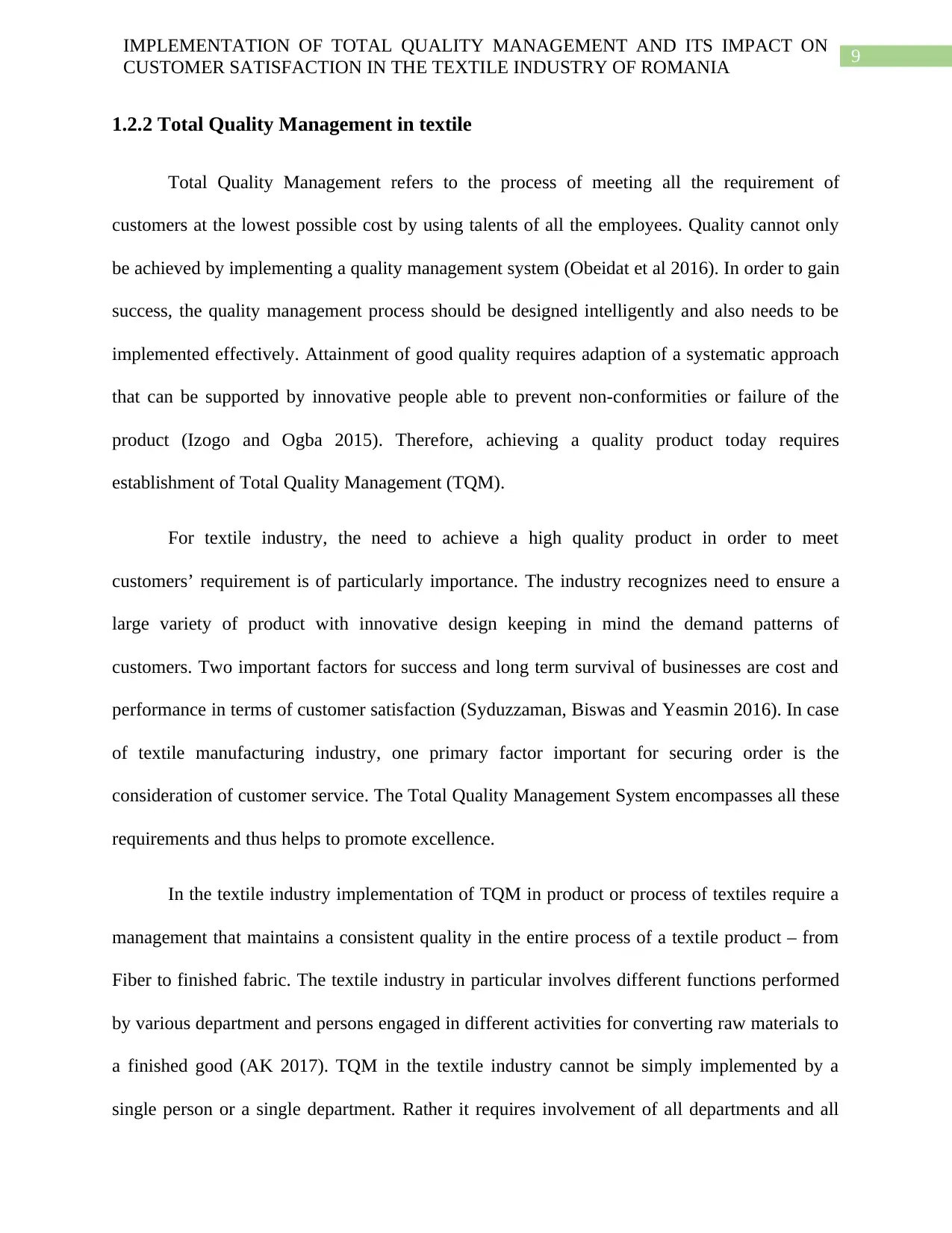
9
IMPLEMENTATION OF TOTAL QUALITY MANAGEMENT AND ITS IMPACT ON
CUSTOMER SATISFACTION IN THE TEXTILE INDUSTRY OF ROMANIA
1.2.2 Total Quality Management in textile
Total Quality Management refers to the process of meeting all the requirement of
customers at the lowest possible cost by using talents of all the employees. Quality cannot only
be achieved by implementing a quality management system (Obeidat et al 2016). In order to gain
success, the quality management process should be designed intelligently and also needs to be
implemented effectively. Attainment of good quality requires adaption of a systematic approach
that can be supported by innovative people able to prevent non-conformities or failure of the
product (Izogo and Ogba 2015). Therefore, achieving a quality product today requires
establishment of Total Quality Management (TQM).
For textile industry, the need to achieve a high quality product in order to meet
customers’ requirement is of particularly importance. The industry recognizes need to ensure a
large variety of product with innovative design keeping in mind the demand patterns of
customers. Two important factors for success and long term survival of businesses are cost and
performance in terms of customer satisfaction (Syduzzaman, Biswas and Yeasmin 2016). In case
of textile manufacturing industry, one primary factor important for securing order is the
consideration of customer service. The Total Quality Management System encompasses all these
requirements and thus helps to promote excellence.
In the textile industry implementation of TQM in product or process of textiles require a
management that maintains a consistent quality in the entire process of a textile product – from
Fiber to finished fabric. The textile industry in particular involves different functions performed
by various department and persons engaged in different activities for converting raw materials to
a finished good (AK 2017). TQM in the textile industry cannot be simply implemented by a
single person or a single department. Rather it requires involvement of all departments and all
IMPLEMENTATION OF TOTAL QUALITY MANAGEMENT AND ITS IMPACT ON
CUSTOMER SATISFACTION IN THE TEXTILE INDUSTRY OF ROMANIA
1.2.2 Total Quality Management in textile
Total Quality Management refers to the process of meeting all the requirement of
customers at the lowest possible cost by using talents of all the employees. Quality cannot only
be achieved by implementing a quality management system (Obeidat et al 2016). In order to gain
success, the quality management process should be designed intelligently and also needs to be
implemented effectively. Attainment of good quality requires adaption of a systematic approach
that can be supported by innovative people able to prevent non-conformities or failure of the
product (Izogo and Ogba 2015). Therefore, achieving a quality product today requires
establishment of Total Quality Management (TQM).
For textile industry, the need to achieve a high quality product in order to meet
customers’ requirement is of particularly importance. The industry recognizes need to ensure a
large variety of product with innovative design keeping in mind the demand patterns of
customers. Two important factors for success and long term survival of businesses are cost and
performance in terms of customer satisfaction (Syduzzaman, Biswas and Yeasmin 2016). In case
of textile manufacturing industry, one primary factor important for securing order is the
consideration of customer service. The Total Quality Management System encompasses all these
requirements and thus helps to promote excellence.
In the textile industry implementation of TQM in product or process of textiles require a
management that maintains a consistent quality in the entire process of a textile product – from
Fiber to finished fabric. The textile industry in particular involves different functions performed
by various department and persons engaged in different activities for converting raw materials to
a finished good (AK 2017). TQM in the textile industry cannot be simply implemented by a
single person or a single department. Rather it requires involvement of all departments and all
Paraphrase This Document
Need a fresh take? Get an instant paraphrase of this document with our AI Paraphraser
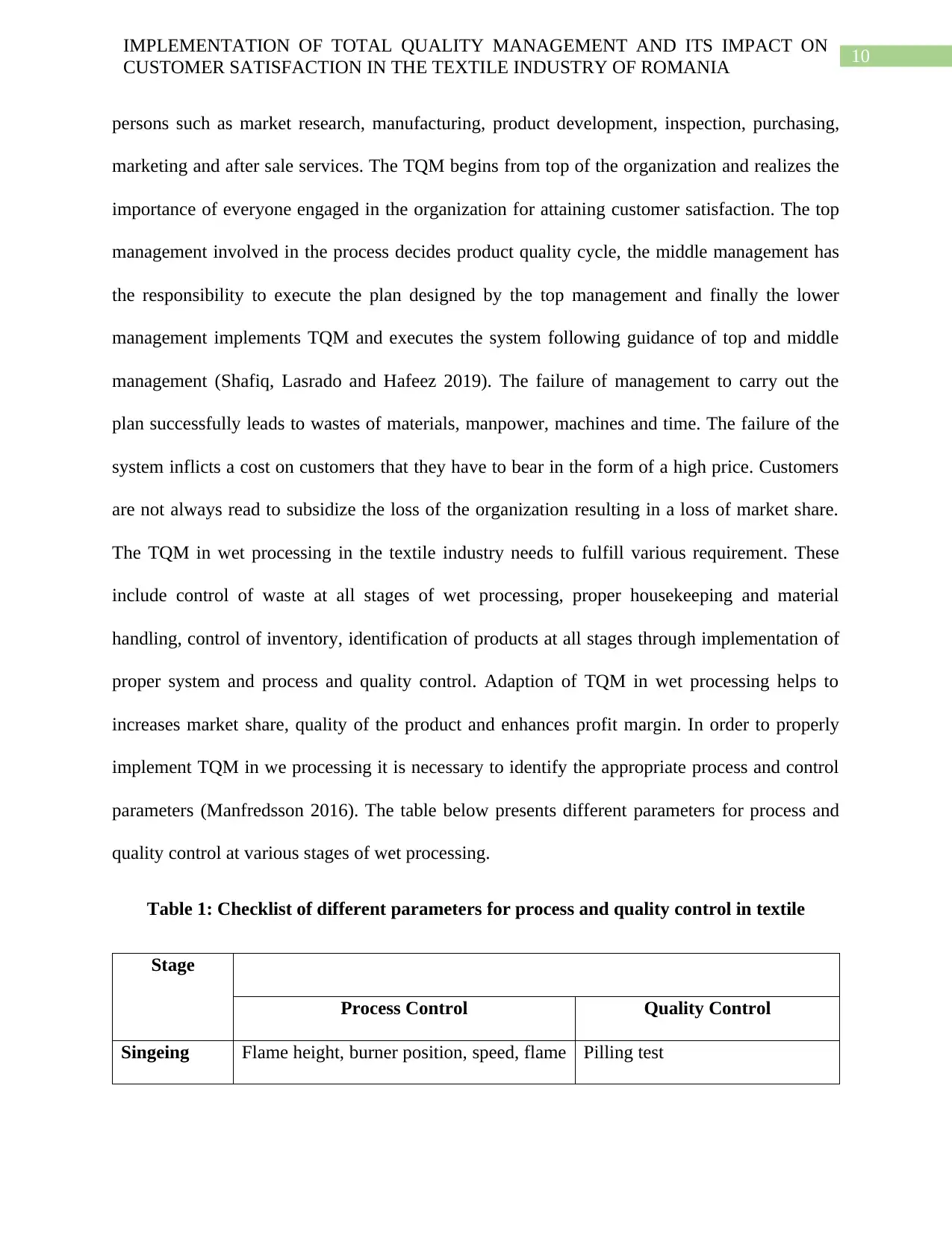
10
IMPLEMENTATION OF TOTAL QUALITY MANAGEMENT AND ITS IMPACT ON
CUSTOMER SATISFACTION IN THE TEXTILE INDUSTRY OF ROMANIA
persons such as market research, manufacturing, product development, inspection, purchasing,
marketing and after sale services. The TQM begins from top of the organization and realizes the
importance of everyone engaged in the organization for attaining customer satisfaction. The top
management involved in the process decides product quality cycle, the middle management has
the responsibility to execute the plan designed by the top management and finally the lower
management implements TQM and executes the system following guidance of top and middle
management (Shafiq, Lasrado and Hafeez 2019). The failure of management to carry out the
plan successfully leads to wastes of materials, manpower, machines and time. The failure of the
system inflicts a cost on customers that they have to bear in the form of a high price. Customers
are not always read to subsidize the loss of the organization resulting in a loss of market share.
The TQM in wet processing in the textile industry needs to fulfill various requirement. These
include control of waste at all stages of wet processing, proper housekeeping and material
handling, control of inventory, identification of products at all stages through implementation of
proper system and process and quality control. Adaption of TQM in wet processing helps to
increases market share, quality of the product and enhances profit margin. In order to properly
implement TQM in we processing it is necessary to identify the appropriate process and control
parameters (Manfredsson 2016). The table below presents different parameters for process and
quality control at various stages of wet processing.
Table 1: Checklist of different parameters for process and quality control in textile
Stage
Process Control Quality Control
Singeing Flame height, burner position, speed, flame Pilling test
IMPLEMENTATION OF TOTAL QUALITY MANAGEMENT AND ITS IMPACT ON
CUSTOMER SATISFACTION IN THE TEXTILE INDUSTRY OF ROMANIA
persons such as market research, manufacturing, product development, inspection, purchasing,
marketing and after sale services. The TQM begins from top of the organization and realizes the
importance of everyone engaged in the organization for attaining customer satisfaction. The top
management involved in the process decides product quality cycle, the middle management has
the responsibility to execute the plan designed by the top management and finally the lower
management implements TQM and executes the system following guidance of top and middle
management (Shafiq, Lasrado and Hafeez 2019). The failure of management to carry out the
plan successfully leads to wastes of materials, manpower, machines and time. The failure of the
system inflicts a cost on customers that they have to bear in the form of a high price. Customers
are not always read to subsidize the loss of the organization resulting in a loss of market share.
The TQM in wet processing in the textile industry needs to fulfill various requirement. These
include control of waste at all stages of wet processing, proper housekeeping and material
handling, control of inventory, identification of products at all stages through implementation of
proper system and process and quality control. Adaption of TQM in wet processing helps to
increases market share, quality of the product and enhances profit margin. In order to properly
implement TQM in we processing it is necessary to identify the appropriate process and control
parameters (Manfredsson 2016). The table below presents different parameters for process and
quality control at various stages of wet processing.
Table 1: Checklist of different parameters for process and quality control in textile
Stage
Process Control Quality Control
Singeing Flame height, burner position, speed, flame Pilling test
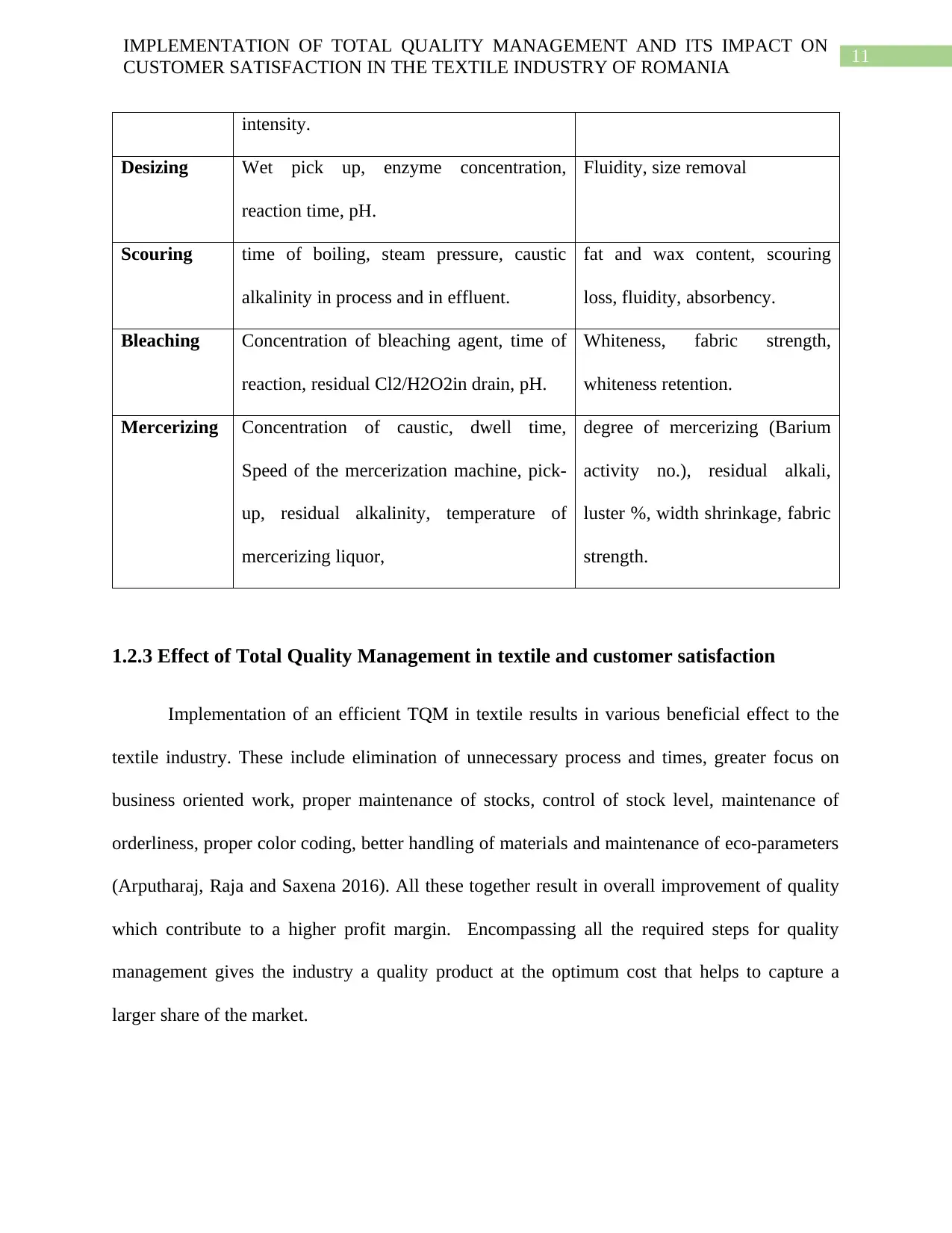
11
IMPLEMENTATION OF TOTAL QUALITY MANAGEMENT AND ITS IMPACT ON
CUSTOMER SATISFACTION IN THE TEXTILE INDUSTRY OF ROMANIA
intensity.
Desizing Wet pick up, enzyme concentration,
reaction time, pH.
Fluidity, size removal
Scouring time of boiling, steam pressure, caustic
alkalinity in process and in effluent.
fat and wax content, scouring
loss, fluidity, absorbency.
Bleaching Concentration of bleaching agent, time of
reaction, residual Cl2/H2O2in drain, pH.
Whiteness, fabric strength,
whiteness retention.
Mercerizing Concentration of caustic, dwell time,
Speed of the mercerization machine, pick-
up, residual alkalinity, temperature of
mercerizing liquor,
degree of mercerizing (Barium
activity no.), residual alkali,
luster %, width shrinkage, fabric
strength.
1.2.3 Effect of Total Quality Management in textile and customer satisfaction
Implementation of an efficient TQM in textile results in various beneficial effect to the
textile industry. These include elimination of unnecessary process and times, greater focus on
business oriented work, proper maintenance of stocks, control of stock level, maintenance of
orderliness, proper color coding, better handling of materials and maintenance of eco-parameters
(Arputharaj, Raja and Saxena 2016). All these together result in overall improvement of quality
which contribute to a higher profit margin. Encompassing all the required steps for quality
management gives the industry a quality product at the optimum cost that helps to capture a
larger share of the market.
IMPLEMENTATION OF TOTAL QUALITY MANAGEMENT AND ITS IMPACT ON
CUSTOMER SATISFACTION IN THE TEXTILE INDUSTRY OF ROMANIA
intensity.
Desizing Wet pick up, enzyme concentration,
reaction time, pH.
Fluidity, size removal
Scouring time of boiling, steam pressure, caustic
alkalinity in process and in effluent.
fat and wax content, scouring
loss, fluidity, absorbency.
Bleaching Concentration of bleaching agent, time of
reaction, residual Cl2/H2O2in drain, pH.
Whiteness, fabric strength,
whiteness retention.
Mercerizing Concentration of caustic, dwell time,
Speed of the mercerization machine, pick-
up, residual alkalinity, temperature of
mercerizing liquor,
degree of mercerizing (Barium
activity no.), residual alkali,
luster %, width shrinkage, fabric
strength.
1.2.3 Effect of Total Quality Management in textile and customer satisfaction
Implementation of an efficient TQM in textile results in various beneficial effect to the
textile industry. These include elimination of unnecessary process and times, greater focus on
business oriented work, proper maintenance of stocks, control of stock level, maintenance of
orderliness, proper color coding, better handling of materials and maintenance of eco-parameters
(Arputharaj, Raja and Saxena 2016). All these together result in overall improvement of quality
which contribute to a higher profit margin. Encompassing all the required steps for quality
management gives the industry a quality product at the optimum cost that helps to capture a
larger share of the market.
⊘ This is a preview!⊘
Do you want full access?
Subscribe today to unlock all pages.

Trusted by 1+ million students worldwide
1 out of 73
Related Documents
Your All-in-One AI-Powered Toolkit for Academic Success.
+13062052269
info@desklib.com
Available 24*7 on WhatsApp / Email
![[object Object]](/_next/static/media/star-bottom.7253800d.svg)
Unlock your academic potential
Copyright © 2020–2025 A2Z Services. All Rights Reserved. Developed and managed by ZUCOL.





